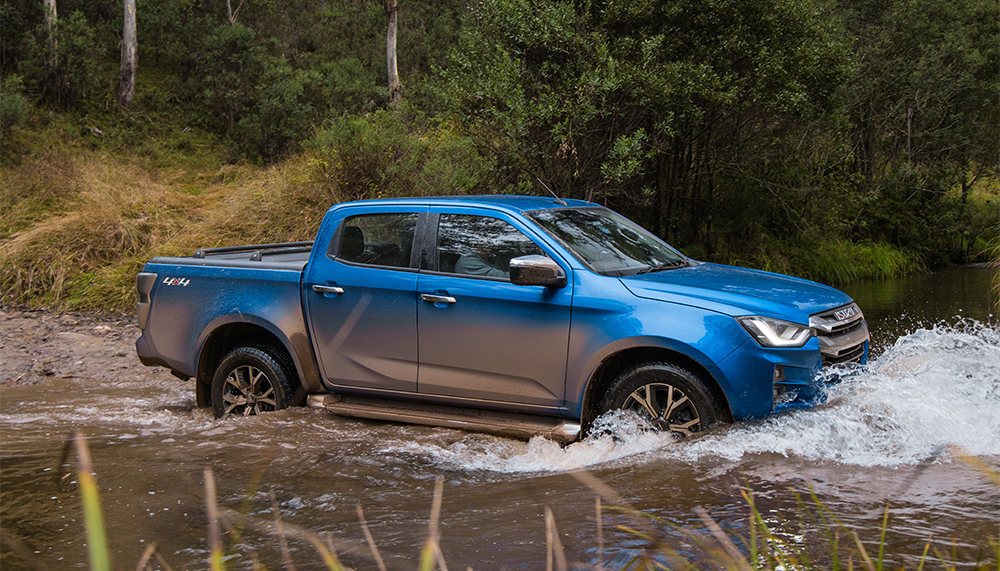Isuzu’s D-MAX is a new standard bearer.
Story Bruce McMahon
Isuzu utes have a long-established reputation across Australia, back some 50 years to those re-badged as Chevrolet LUVs and then Holden Rodeos. Known as honest, reliable workhorses engineered by a reputable Japanese truck company, those early utes were rugged, hard-wearing machines and never too fancy. The latest Isuzu utes are more capable and, more importantly perhaps, more comfortable.
The first of the Isuzu D-MAX models arrived in Australia in 2003, initially badged as a Holden Colorado before being introduced as a standalone Isuzu product from 2008. That D-MAX ute and its sibling the MU-X wagon have cemented well-earned spots on Australian sales charts.
The third generation 2020 D-MAX – with minor updates in 2023 – has lifted style and substance. The new machine is up there with rivals in one of the most competitive automotive market sectors in the world.
While today’s range extends through to a plusher LS-U+ version, all models maintain the Isuzu’s reputation as work-ready, with tried and trusted diesel powerplants – good for driveability, economy and towing. There’s a 1.9L version for the most basic SX models, with a 3L, turbocharged diesel offered right across the range. It’s the biggest 4-cylinder diesel in its class and offers 140kW of power and a welcome 450Nm of torque.
Both engines can be mated to a 6-speed automatic or manual transmission. Towing capacity for the 3L engine is rated at 3.5 tonnes. Fuel consumption on a week-long run, with light to medium loads from highway to paddocks, was 8.3L/100km in an LS-U.
While the 5.2m long D-MAX has a fair amount of bulk to shift, all that torque arrives at an early 1600rpm, meaning it’s easy to get back wheels chirping from take-off and easy to get a trailer, or a 985kg payload, on the move. And while this motor rolls on with a lazy diesel drawl, the combination of a better-composed chassis (with benefits to both ride and handling), swisher interiors in the upmarket Isuzus, plus a smooth automatic gearbox means a driver needs to keep an eye on back road speed limits.
This generation of 4WD utes surpasses the last with a more subtle, more sophisticated drive experience. There are real alternatives to Sports Utility Vehicles among this latest mob, even allowing for some occasional hop-skip from an unladen rear end. Be warned that this refinement can cost – it’s easy enough to get a fancy D-MAX up to $75,000 with the addition of a handful of options.
Once past those SX versions though, most D-MAX models want for little. The list of safety aids, from rear cross-traffic alerts to a driver attention monitor to 8 airbags, is extensive and most are fitted across the range of 27 variants. There are numerous buzzers and bells and warning lights. Some, such as the autonomous emergency braking, can actually be too reactive and perhaps there are one too many aids for quiet country drives, where running over white lines, for instance, may be par for the course. Many rural folk will be delving into the driver’s handbook to switch off some well-intentioned helpers.
Otherwise, the new generation D-MAX dual cabs are relatively quiet and comfortable for a relaxed long haul. The ergonomic interior has controls to hand, although small steering wheel buttons take some learning and there’s no volume knob for the audio system. Seats up front are good – far better than in the old days – and there’s reasonable room in the rear.
A myriad of vehicle information details, from fuel range and direction of travel to average speeds, is available on intuitive touch screens. There’s Apple CarPlay and Android Auto compatibility. LS-U and X-Terrain models score tyre pressure monitoring systems – one of the more useful add-ons to be found in a touring vehicle.
The 4WD versions with high and low range can take on all manner of terrain from mud to sand to rocks to rutted bush roads, but it is the new-found on-road comforts, thanks to reworked suspension, chassis and body, which mean the D-MAX is now more than just a reliable work mate.
This story excerpt is from Issue #150
Outback Magazine: Aug/Sep 2023










